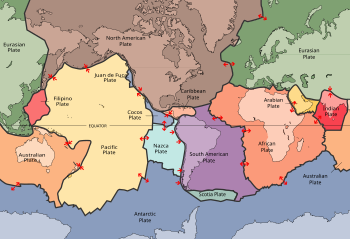
Back Aardkors Afrikaans Crosta terrestre AN Hrūse ANG القشرة الأرضية Arabic Corteya terrestre AST Yer qabığı Azerbaijani یئر قابیغی AZB Ер ҡабығы Bashkir Зямная кара Byelorussian Зямная кара BE-X-OLD

Earth's crust is its thick outer shell of rock, referring to less than one percent of the planet's radius and volume. It is the top component of the lithosphere, a solidified division of Earth's layers that includes the crust and the upper part of the mantle.[1] The lithosphere is broken into tectonic plates whose motion allows heat to escape the interior of Earth into space.
The crust lies on top of the mantle, a configuration that is stable because the upper mantle is made of peridotite and is therefore significantly denser than the crust. The boundary between the crust and mantle is conventionally placed at the Mohorovičić discontinuity, a boundary defined by a contrast in seismic velocity.

| Extended crust | Oceanic crust: 0–20 Ma 20–65 Ma >65 Ma |
The temperature of the crust increases with depth,[2] reaching values typically in the range from about 100 °C (212 °F) to 600 °C (1,112 °F) at the boundary with the underlying mantle. The temperature increases by as much as 30 °C (54 °F) for every kilometer locally in the upper part of the crust.[3]
Earth's thin, 40-kilometre (25-mile) deep crust—just one percent of Earth’s mass—contains all known life in the Universe.[4]
- ^ Robinson, Eugene C. (January 14, 2011). "The Interior of the Earth". U.S. Geological Survey. Retrieved August 30, 2013.
- ^ Peele, Robert (1911). . In Chisholm, Hugh (ed.). Encyclopædia Britannica. Vol. 4 (11th ed.). Cambridge University Press. p. 251.
- ^ Philpotts, Anthony R.; Ague, Jay J. (2009). Principles of igneous and metamorphic petrology (2nd ed.). Cambridge, UK: Cambridge University Press. p. 14. ISBN 978-0-521-88006-0.
- ^ National Geographic: Crust